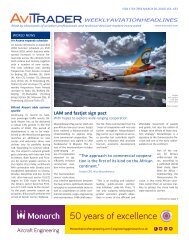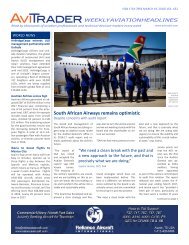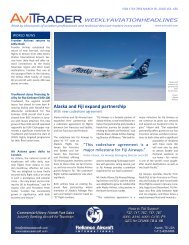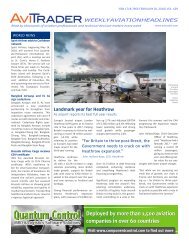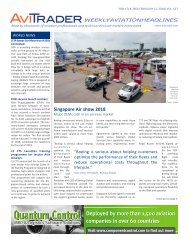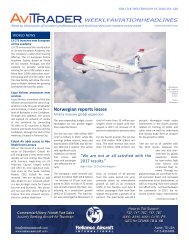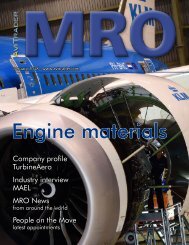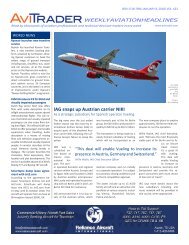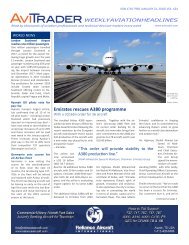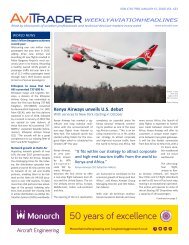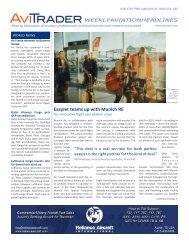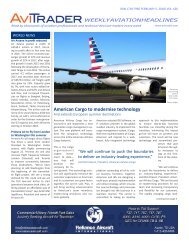AviTrader_Monthly_MRO_e-Magazine_2013-06
AviTrader_Monthly_MRO_e-Magazine_2013-06
AviTrader_Monthly_MRO_e-Magazine_2013-06
Create successful ePaper yourself
Turn your PDF publications into a flip-book with our unique Google optimized e-Paper software.
IBA Analysis 15<br />
Ageing Aircraft Maintenance: The costs<br />
and challenges By Ben Jacques<br />
variable due to the flying environment, the<br />
particular maintenance regime or where the<br />
fleet happens to be in its life cycle.<br />
There is much discussion<br />
of aircraft economic life<br />
shortening, although this<br />
can be difficult to prove and<br />
sweeping generalisations<br />
are often made. The reality<br />
for an airline looking at<br />
particular tail numbers on<br />
a case by case basis often<br />
hinges on the expected<br />
maintenance costs to<br />
keep an aircraft in revenue<br />
service. An aircraft needs to<br />
prove its ability to pay its<br />
way into the future. The key<br />
words in that sentence are<br />
the expected maintenance<br />
costs. Expecting and<br />
anticipating something<br />
failing is proactive.<br />
Lufthansa workhorse for decades - the aging 737 classic<br />
Approaches to maintenance differ across the<br />
industry. There are those who are fastidious<br />
in their planning and execution, leaving<br />
nothing to chance, whilst at the other end of<br />
the spectrum there are those who understand<br />
a safe operation, what it means to them and<br />
their team but see proactivity as a luxury, or<br />
perhaps a chore.<br />
However, in a modern world where cost<br />
management is one of the single biggest<br />
challenges for an airline, those without the<br />
most proactive cost-aware maintenance<br />
strategies can represent something quite<br />
scary with regard to the balance sheet.<br />
Flying a new, robust, modern airliner is<br />
reasonably straightforward as the OEMs have<br />
routine maintenance down to a fine art. A<br />
fleet of modern narrowbody or widebody jets<br />
fresh from the OEM factory will be perfectly<br />
manageable for most maintenance programs<br />
and most airline management structures.<br />
Then when the time comes to replace the<br />
fleet, the operator has a similar cost structure<br />
for the next eight to 10 years depending<br />
on their replacement policy. The finance<br />
team are happy as everything is visible and<br />
costs are virtually fixed throughout the<br />
programme.<br />
An identical fleet of aircraft however, with<br />
the sole difference of being 10 to 15-yearsold<br />
and having accumulated the industry<br />
average number of hours and cycles, adds<br />
complexities for many airlines, not only from<br />
a maintenance perspective, but from an<br />
operational perspective as well.<br />
“...many airlines have<br />
had to rethink their<br />
aircraft replacement<br />
policies.”<br />
Over the last four to six years, many airlines<br />
have had to rethink their aircraft replacement<br />
policies. They have looked at air show orders<br />
with envy, wishing it was their operation<br />
ordering three figures worth of brand new<br />
aircraft, but alas their operation is persevering<br />
with a mature fleet.<br />
Aircraft maintenance can represent<br />
somewhere between 10 to 25 per cent<br />
of an airline’s direct operating costs. The<br />
reason this range is so large is as diverse as<br />
the global fleet itself. For example, it can be<br />
To be successful this often<br />
needs to be combined with<br />
a positive attitude to not<br />
only anticipate due items,<br />
but to manage those not yet<br />
due or those with increasing<br />
probability to fail before<br />
Photo: AirTeamImages they are due, to further<br />
extend the in-service period<br />
for the aircraft before the next significant<br />
step, which by now would be disposal.<br />
Taking a decision to operate older aircraft<br />
will create challenges and it is not a decision<br />
taken lightly. The time needs to be right for<br />
all parties. An airline might well be fretting<br />
about maintenance costs going forward, but<br />
a lessor might well be equally fretting about<br />
where the next placement might be and how<br />
much investment is required to achieve a<br />
sensible rental during the next placement.<br />
This poses an interesting question – can a<br />
lessor make an attractive lease deal without<br />
harming themselves and prolonging the<br />
useful economic life of the aircraft for the<br />
airline? In many cases the answer is yes.<br />
For line maintenance there are some specific<br />
considerations if the policy of operating older<br />
aircraft is to be seriously considered.<br />
Line mechanics require more detailed training<br />
on troubleshooting defects and their system<br />
knowledge may need to be more detailed in<br />
order to keep downtime to a minimum. This<br />
is especially relevant to older aircraft as when<br />
numerous service bulletins and airworthiness<br />
directives are incorporated, they can<br />
significantly change system operations and<br />
<strong>AviTrader</strong> <strong>MRO</strong> - June <strong>2013</strong>





